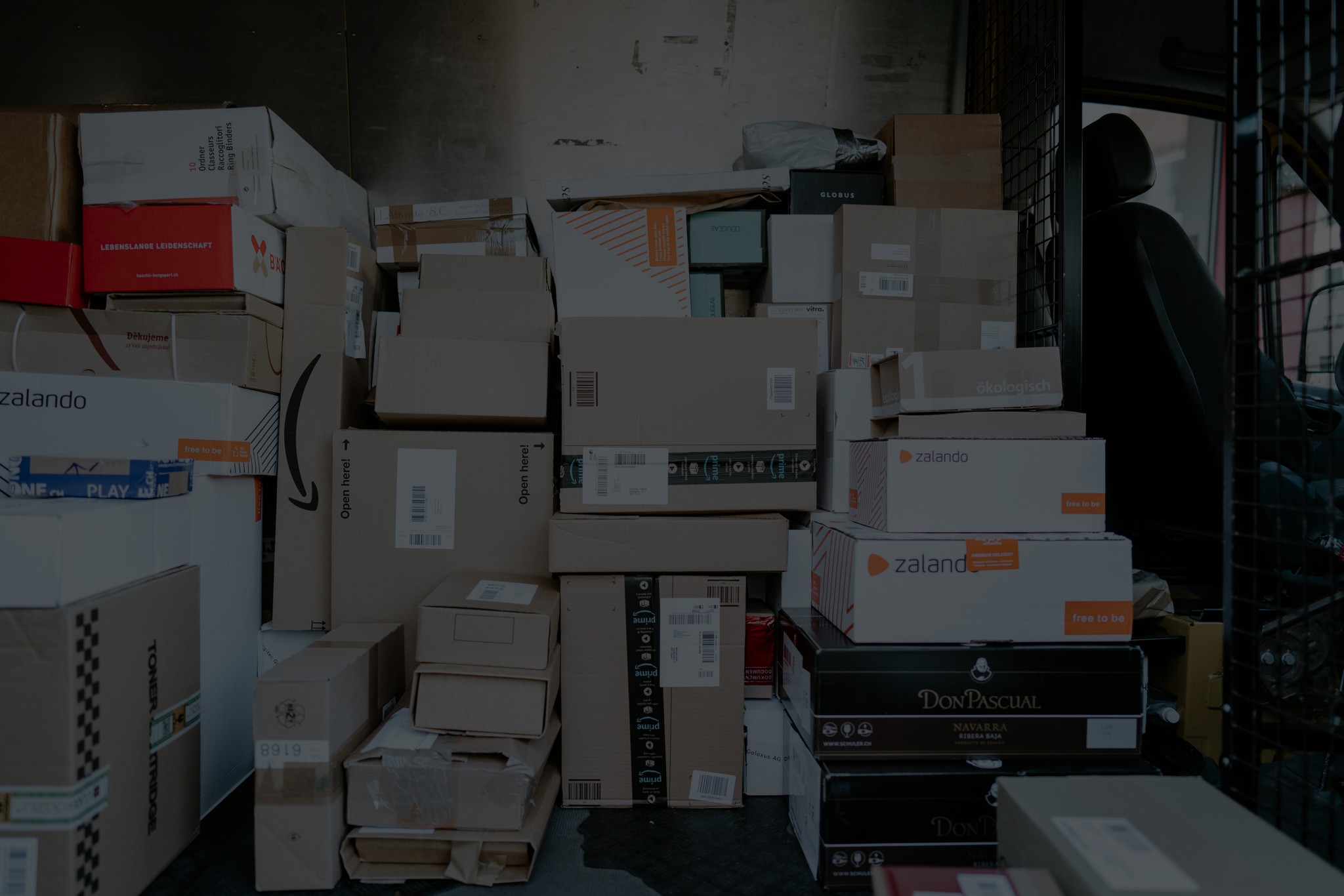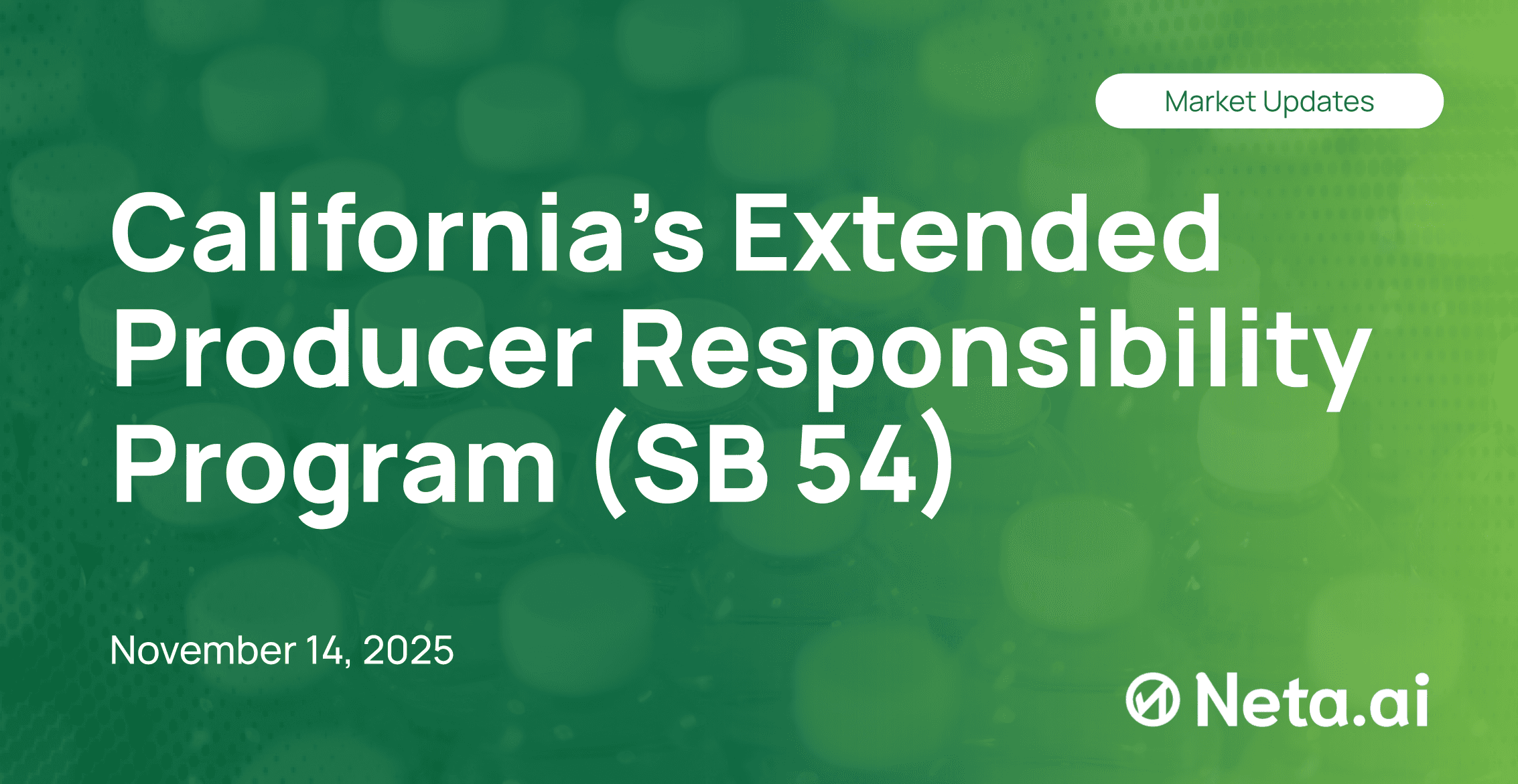EU Packaging and Packaging Waste Regulation (PPWR)
EU Packaging and Packaging Waste Regulation (PPWR)
EU Packaging and Packaging Waste Regulation (PPWR)
MARKET UPDATES
July 28, 2025

Grace Lam
Grace Lam
·
Co-founder

Samiya Sen
Samiya Sen
·
Blog contributor



Packaging is often expensive, resource-intensive, and hard to recycle. Governments are left managing the waste using taxpayers’ money. In the European Union, sustainable packaging is no longer a nice-to-have, it’s now the law to help governments tackle packaging wastes amount to nearly 190 kilograms per person.
The Packaging and Packaging Waste Regulation (PPWR) is a landmark EU law targeting packaging waste and supporting a circular economy. Adopted in late 2024 and entering into force in February 2025, the PPWR replaces an older directive and sets unified requirements across all member states. The goal is to curb the surge in packaging waste by making packaging more reusable, recyclable, and sustainable.
Key Takeaways
PPWR is a new EU-wide regulation that harmonizes packaging rules, replacing the 1994 directive with uniform standards to foster a circular economy. It sets new targets and requirements covering the entire packaging lifecycle.
By 2030, all packaging sold in the EU must be recyclable. The regulation also imposes reuse targets, recycled content minimums (30%-65%), and restrictions on single-use plastic and wasteful packaging formats.
PPWR pushes companies to innovate packaging that can be collected and recycled efficiently, while harmonizing member states’ EPR schemes to cover costs. This will significantly affect sectors like food service, online retail, and consumer goods.
Packaging is often expensive, resource-intensive, and hard to recycle. Governments are left managing the waste using taxpayers’ money. In the European Union, sustainable packaging is no longer a nice-to-have, it’s now the law to help governments tackle packaging wastes amount to nearly 190 kilograms per person.
The Packaging and Packaging Waste Regulation (PPWR) is a landmark EU law targeting packaging waste and supporting a circular economy. Adopted in late 2024 and entering into force in February 2025, the PPWR replaces an older directive and sets unified requirements across all member states. The goal is to curb the surge in packaging waste by making packaging more reusable, recyclable, and sustainable.
Key Takeaways
PPWR is a new EU-wide regulation that harmonizes packaging rules, replacing the 1994 directive with uniform standards to foster a circular economy. It sets new targets and requirements covering the entire packaging lifecycle.
By 2030, all packaging sold in the EU must be recyclable. The regulation also imposes reuse targets, recycled content minimums (30%-65%), and restrictions on single-use plastic and wasteful packaging formats.
PPWR pushes companies to innovate packaging that can be collected and recycled efficiently, while harmonizing member states’ EPR schemes to cover costs. This will significantly affect sectors like food service, online retail, and consumer goods.
What is PPWR?
The PPWR is a comprehensive EU law that overhauls packaging design, use, and disposal across Europe. Replacing the 1994 Packaging and Packaging Waste Directive (PPWD), it was adopted in December 2024 and entered into force in February 2025. Unlike directives, which member states interpret into national laws, this regulation is immediately binding across all EU countries. This ensures consistent standards for packaging recyclability, labeling, and material usage.
Recent growth in e-commerce and single-use packaging has driven waste to outpace recycling. PPWR tackles this by introducing stricter standards for recyclability and reuse. It eliminates national inconsistencies, creates a single EU market for compliant packaging, and promotes a circular economy.
PPWR Core Components
Recyclability Standards: By 2030, all packaging must be recyclable, as defined by design for recycling (DfR) criteria and recyclability performance grades. Formats that cannot be readily collected and processed will be phased out.
Recycled Material Requirements: Plastic packaging must contain a minimum of 30% recycled content by 2030, rising to 65% by 2040.
Mandatory Reuse Targets: Sectors like e-commerce, food service, and transport packaging must offer reusable options. Retailers must provide refill stations in at least 10% of store area.
Packaging Format Restrictions: Bans will apply to wasteful packaging types like mini hotel toiletries, disposable dine-in containers, and very lightweight plastic bags.
Waste Reduction Measures: Empty space in boxes will be capped at 50%. Double-packaging will be restricted to reduce volume and improve logistics.
PFAS Chemical Ban: Use of intentionally added PFAS in food-contact packaging will be banned 18 months after the law enters into force.
Standardized Labeling: All packaging must carry EU-wide labels showing material type and disposal instructions. QR codes may link to recycling guidance.
Impacts on Extended Producer Responsibility (EPR)
EPR systems are already in place in many EU member states. However, as the previous PPWD allows each country to interpret and enforce EPR differently, it has led to widely varying systems for producer registration, fee calculations, reporting requirements, and enforcement, creating significant compliance challenges for companies operating across borders.
The PPWR aims to harmonize EPR across the EU by:
Modulating fees based on recyclability and reuse performance
Requiring cross‑country registration and detailed packaging data reporting
Aligning producer obligations across all Member States, eliminating the national inconsistencies under the PPWD
This shift places more financial and operational responsibility onto producers, but also reduces uncertainty and administrative complexity, encouraging more sustainable packaging design and rewarding those whose packaging scores well on recyclability and reuse.
Timelines and Implementation
The PPWR is a complex regulation with ambitious targets and long-term implementation milestones. While the full scope is extensive, here are key dates to guide your planning. For tailored guidance, feel free to connect with the Neta team!
Key dates include:
2025: Law enters into force
2026: Conformity assessments begin
2027: EPR and recyclability reporting obligations start
2028: Compostables and EU-wide labeling required
2029: Deposit return systems active for beverage containers
2030: All packaging must be recyclable; reuse and content targets apply
2035: Midpoint review
2040: Full compliance with waste and recyclability goals
How Businesses Can Adapt
Companies operating in the EU should focus on three key areas:
Packaging Design & Sourcing: Redesign packaging to meet recyclability and reuse requirements. Switch to mono-materials and increase use of certified recycled content to reduce non-compliance risk and EPR fees.
Labeling & Documentation: Integrate EU-standard labels into packaging artwork by 2028 and prepare documentation demonstrating recyclability, material composition, and recycled content.
Reuse Systems & EPR Strategy: Develop or partner on packaging reuse programs and model future EPR fees. Early investment in systems and materials can lower long-term compliance costs and create operational efficiencies.
Conclusion
Staying compliant with the PPWR requires more than just good intentions; it demands systems that can track, analyze, and adapt. At Neta, we help brands turn regulatory pressure into packaging intelligence. Our platform equips businesses with the tools to navigate shifting requirements like the PPWR, mapping packaging SKUs to recyclability criteria, simulating redesign tradeoffs, and forecasting EPR fees. As Europe moves from policy to enforcement, we’re here to make sure your packaging strategy stays ahead.
What is PPWR?
The PPWR is a comprehensive EU law that overhauls packaging design, use, and disposal across Europe. Replacing the 1994 Packaging and Packaging Waste Directive (PPWD), it was adopted in December 2024 and entered into force in February 2025. Unlike directives, which member states interpret into national laws, this regulation is immediately binding across all EU countries. This ensures consistent standards for packaging recyclability, labeling, and material usage.
Recent growth in e-commerce and single-use packaging has driven waste to outpace recycling. PPWR tackles this by introducing stricter standards for recyclability and reuse. It eliminates national inconsistencies, creates a single EU market for compliant packaging, and promotes a circular economy.
PPWR Core Components
Recyclability Standards: By 2030, all packaging must be recyclable, as defined by design for recycling (DfR) criteria and recyclability performance grades. Formats that cannot be readily collected and processed will be phased out.
Recycled Material Requirements: Plastic packaging must contain a minimum of 30% recycled content by 2030, rising to 65% by 2040.
Mandatory Reuse Targets: Sectors like e-commerce, food service, and transport packaging must offer reusable options. Retailers must provide refill stations in at least 10% of store area.
Packaging Format Restrictions: Bans will apply to wasteful packaging types like mini hotel toiletries, disposable dine-in containers, and very lightweight plastic bags.
Waste Reduction Measures: Empty space in boxes will be capped at 50%. Double-packaging will be restricted to reduce volume and improve logistics.
PFAS Chemical Ban: Use of intentionally added PFAS in food-contact packaging will be banned 18 months after the law enters into force.
Standardized Labeling: All packaging must carry EU-wide labels showing material type and disposal instructions. QR codes may link to recycling guidance.
Impacts on Extended Producer Responsibility (EPR)
EPR systems are already in place in many EU member states. However, as the previous PPWD allows each country to interpret and enforce EPR differently, it has led to widely varying systems for producer registration, fee calculations, reporting requirements, and enforcement, creating significant compliance challenges for companies operating across borders.
The PPWR aims to harmonize EPR across the EU by:
Modulating fees based on recyclability and reuse performance
Requiring cross‑country registration and detailed packaging data reporting
Aligning producer obligations across all Member States, eliminating the national inconsistencies under the PPWD
This shift places more financial and operational responsibility onto producers, but also reduces uncertainty and administrative complexity, encouraging more sustainable packaging design and rewarding those whose packaging scores well on recyclability and reuse.
Timelines and Implementation
The PPWR is a complex regulation with ambitious targets and long-term implementation milestones. While the full scope is extensive, here are key dates to guide your planning. For tailored guidance, feel free to connect with the Neta team!
Key dates include:
2025: Law enters into force
2026: Conformity assessments begin
2027: EPR and recyclability reporting obligations start
2028: Compostables and EU-wide labeling required
2029: Deposit return systems active for beverage containers
2030: All packaging must be recyclable; reuse and content targets apply
2035: Midpoint review
2040: Full compliance with waste and recyclability goals
How Businesses Can Adapt
Companies operating in the EU should focus on three key areas:
Packaging Design & Sourcing: Redesign packaging to meet recyclability and reuse requirements. Switch to mono-materials and increase use of certified recycled content to reduce non-compliance risk and EPR fees.
Labeling & Documentation: Integrate EU-standard labels into packaging artwork by 2028 and prepare documentation demonstrating recyclability, material composition, and recycled content.
Reuse Systems & EPR Strategy: Develop or partner on packaging reuse programs and model future EPR fees. Early investment in systems and materials can lower long-term compliance costs and create operational efficiencies.
Conclusion
Staying compliant with the PPWR requires more than just good intentions; it demands systems that can track, analyze, and adapt. At Neta, we help brands turn regulatory pressure into packaging intelligence. Our platform equips businesses with the tools to navigate shifting requirements like the PPWR, mapping packaging SKUs to recyclability criteria, simulating redesign tradeoffs, and forecasting EPR fees. As Europe moves from policy to enforcement, we’re here to make sure your packaging strategy stays ahead.
What is PPWR?
The PPWR is a comprehensive EU law that overhauls packaging design, use, and disposal across Europe. Replacing the 1994 Packaging and Packaging Waste Directive (PPWD), it was adopted in December 2024 and entered into force in February 2025. Unlike directives, which member states interpret into national laws, this regulation is immediately binding across all EU countries. This ensures consistent standards for packaging recyclability, labeling, and material usage.
Recent growth in e-commerce and single-use packaging has driven waste to outpace recycling. PPWR tackles this by introducing stricter standards for recyclability and reuse. It eliminates national inconsistencies, creates a single EU market for compliant packaging, and promotes a circular economy.
PPWR Core Components
Recyclability Standards: By 2030, all packaging must be recyclable, as defined by design for recycling (DfR) criteria and recyclability performance grades. Formats that cannot be readily collected and processed will be phased out.
Recycled Material Requirements: Plastic packaging must contain a minimum of 30% recycled content by 2030, rising to 65% by 2040.
Mandatory Reuse Targets: Sectors like e-commerce, food service, and transport packaging must offer reusable options. Retailers must provide refill stations in at least 10% of store area.
Packaging Format Restrictions: Bans will apply to wasteful packaging types like mini hotel toiletries, disposable dine-in containers, and very lightweight plastic bags.
Waste Reduction Measures: Empty space in boxes will be capped at 50%. Double-packaging will be restricted to reduce volume and improve logistics.
PFAS Chemical Ban: Use of intentionally added PFAS in food-contact packaging will be banned 18 months after the law enters into force.
Standardized Labeling: All packaging must carry EU-wide labels showing material type and disposal instructions. QR codes may link to recycling guidance.
Impacts on Extended Producer Responsibility (EPR)
EPR systems are already in place in many EU member states. However, as the previous PPWD allows each country to interpret and enforce EPR differently, it has led to widely varying systems for producer registration, fee calculations, reporting requirements, and enforcement, creating significant compliance challenges for companies operating across borders.
The PPWR aims to harmonize EPR across the EU by:
Modulating fees based on recyclability and reuse performance
Requiring cross‑country registration and detailed packaging data reporting
Aligning producer obligations across all Member States, eliminating the national inconsistencies under the PPWD
This shift places more financial and operational responsibility onto producers, but also reduces uncertainty and administrative complexity, encouraging more sustainable packaging design and rewarding those whose packaging scores well on recyclability and reuse.
Timelines and Implementation
The PPWR is a complex regulation with ambitious targets and long-term implementation milestones. While the full scope is extensive, here are key dates to guide your planning. For tailored guidance, feel free to connect with the Neta team!
Key dates include:
2025: Law enters into force
2026: Conformity assessments begin
2027: EPR and recyclability reporting obligations start
2028: Compostables and EU-wide labeling required
2029: Deposit return systems active for beverage containers
2030: All packaging must be recyclable; reuse and content targets apply
2035: Midpoint review
2040: Full compliance with waste and recyclability goals
How Businesses Can Adapt
Companies operating in the EU should focus on three key areas:
Packaging Design & Sourcing: Redesign packaging to meet recyclability and reuse requirements. Switch to mono-materials and increase use of certified recycled content to reduce non-compliance risk and EPR fees.
Labeling & Documentation: Integrate EU-standard labels into packaging artwork by 2028 and prepare documentation demonstrating recyclability, material composition, and recycled content.
Reuse Systems & EPR Strategy: Develop or partner on packaging reuse programs and model future EPR fees. Early investment in systems and materials can lower long-term compliance costs and create operational efficiencies.
Conclusion
Staying compliant with the PPWR requires more than just good intentions; it demands systems that can track, analyze, and adapt. At Neta, we help brands turn regulatory pressure into packaging intelligence. Our platform equips businesses with the tools to navigate shifting requirements like the PPWR, mapping packaging SKUs to recyclability criteria, simulating redesign tradeoffs, and forecasting EPR fees. As Europe moves from policy to enforcement, we’re here to make sure your packaging strategy stays ahead.
Since you made it this far, why not sign up for our newsletter?
Since you made it this far, why not sign up for our newsletter?

Make smarter
packaging decisions
See how we can cut your time spent on packaging compliance and data tracking by half

Make smarter
packaging decisions
See how we can cut your time spent on packaging compliance and data tracking by half

Make smarter
packaging decisions
See how we can cut your time spent on packaging compliance and data tracking by half




